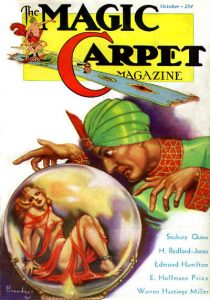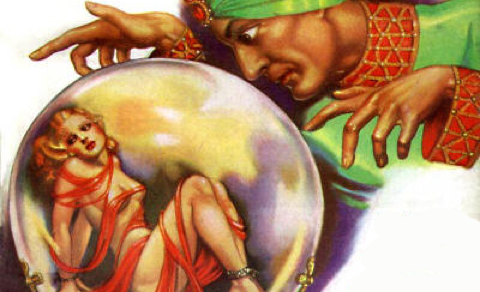 No one defined the look of WEIRD TALES like pulp’s premier cover artist Margaret Brundage. The talented woman who dressed (and undressed) countless Seabury Quinn, Robert E. Howard, Jack Williamson, Edmond Hamilton, and Manly Wade Wellman characters was born December 9, 1900 into a devout Christian Science household in Chicago. Her parents were Swedish and Irish immigrants from Scotland.
No one defined the look of WEIRD TALES like pulp’s premier cover artist Margaret Brundage. The talented woman who dressed (and undressed) countless Seabury Quinn, Robert E. Howard, Jack Williamson, Edmond Hamilton, and Manly Wade Wellman characters was born December 9, 1900 into a devout Christian Science household in Chicago. Her parents were Swedish and Irish immigrants from Scotland.
Editor of her high school newspaper where classmate Walt Disney was a cartoonist, Margaret graduated to become a fashion designer. She supplemented her income with newspaper illustrations and by decorating speakeasies during Prohibition. It was in the latter pursuit that she met and married speakeasy bouncer and janitor Slim Brundage. Her new husband was an alcoholic womanizer, self-professed hobo, and avowed leftist who was born in an insane asylum.
Sadly, as a husband Slim was not a consistent breadwinner. He founded the College of Complexes in 1933, but it closed three months later. He became director of the Hobo College in 1936. His commitment to radical communism led to continuous trouble with authorities and even periods of incarceration.
Forced to support herself, their young son, and her sickly mother, Margaret found work as a cover artist for WEIRD TALES, ORIENTAL STORIES, and MAGIC CARPET. Editor Farnsworth Wright paid her $90 per cover painting. She provided cover art for 66 issues of WEIRD TALES between 1932 and 1945, making her the most in-demand cover artist for the magazine. Only Virgil Finlay was a close rival.
Margaret initially disguised her gender by signing her work as M. Brundage. She redefined sensuality for the already scandalous pulp market, but later found her work the target of New York Mayor LaGuardia’s 1938 decency campaign. Censorship and Farnsworth Wright’s retirement in 1940 saw a lessening of demand for the talented artist in the pulp market.
In spite of her stormy marriage and demanding career depicting half-naked damsels about to be lashed, life was not all Brundage and Discipline for Margaret. Slim abandoned his wife and their son just as America began climbing out of the Great Depression. He would later cash in his pension and re-open the College of Complexes in 1951. It would become Chicago’s most popular beatnik bistro of the decade.
Margaret’s final pulp cover sale was in 1953, but she continued to paint and exhibited and sold her work at art fairs and science fiction conventions. Clark Ashton Smith was highly critical of her sexually-charged paintings as his contemporaneous correspondence with H. P. Lovecraft and R. H. Barlow proved. A leering Forrest J. Ackerman and the dubious claims of L. Sprague de Camp helped keep her work in vogue during the early years of science fiction fandom. Robert Weinberg’s early scholarship did much to correct erroneous claims that she used models (with de Camp propagating the rumor that a nonexistent daughter posed for her, in various stages of undress). Margaret Brundage died in poverty in 1976. Her work survives and continues to define popular conceptions of pulp fiction, sword & sorcery, and weird fantasy.
Pulp scholar and co-founder of the Windy City Pulp and Paper Convention Doug Ellis will present “The Weird Tales of Margaret Brundage” on Friday evening, August 7 as PulpFest 2020 celebrates the 120th anniversary of the birth of Margaret Brundage, the centennial of Ray Bradbury’s birth, and the 100th anniversary of BLACK MASK. The convention will also feature presentations brimming with Baum, Burroughs, Barsoom, Brackett, B-movies, and more, including the beautiful Eva Lynd. Be sure to join us August 6 – 9 at the DoubleTree by Hilton Hotel Pittsburgh – Cranberry in Mars, PA.
(Although remembered primarily for her WEIRD TALES covers, Margaret Brundage also painted covers for other Popular Fiction Publishing magazines. She contributed two covers to ORIENTAL STORIES and twice that number to THE MAGIC CARPET MAGAZINE, including the October 1933 number.
In addition to her sixty-six covers for WEIRD TALES, Brundage also contributed two covers to GOLDEN FLEECE, a Sun Publications pulp magazine, also based in Chicago.
For a more detailed look at Margaret Brundage, we urge you to pick up a copy of Stephen D. Korshak’s and J. David Spurlock’s book, THE ALLURING ART OF MARGARET BRUNDAGE. David’s “book within a book” — entitled “The Secret Life of Margaret Brundage” — was largely used for the biographical information found in our post. Prior to David’s detailed revelations, so much of what is now known about Brundage was totally unknown.
THE ALLURING ART OF MARGARET BRUNDAGE is available through Amazon and other booksellers. You can also get it direct from the publisher — Vanguard Publications — by visiting http://www.vanguardpublishing.com/.)







